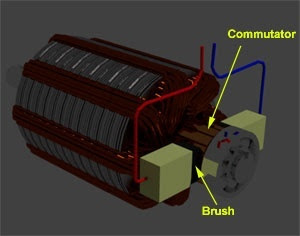As discussed in earlier post, Purpose of Interpole in DC Machine, there are two types of effect of armature mmf on the main field flux:
1) Distortion in Main Field Flux
Due to the above two effects of armature mmf, there are many detrimental effects on the Electrical machine. Distortion of Main Field Flux gives rise to three detrimental effects: Rise in Iron Loss, Poor Commutation and Sparking in Carbon Brushes.
Net reduction in Main Field Flux leads to increased cost of field winding as we need more field winding to have a fixed value of field flux.
Now we will discuss each of the bad effects of armature reaction briefly but in systematic way as follow:
Rise in Iron Loss: Iron loss basically depends on the maximum value of flux density in the teeth and in pole shoes. Because of armature reaction the value of flux density increases considerably over its value at no load. As a result, Iron Loss specially at teeth and pole shoes are much more greater at load when compared to no load values. Also, because of increase of magnetic flux density in the teeth and pole shoes cause it to saturate which in turn results into the stray flux at end plates and covers. This leads to more eddy current and hysteresis loss. Iron loss at full is nearly about 1.5 times that of its value at no load.
Poor Commutation: At no load, zero crossing of flux density wave is along GNA but under loading condition of DC Machine the zero crossing of flux density wave shifts by an angle of Ɵ from GNA. This shift Ɵ depends on the magnitude of load current i.e. armature current. The greater the armature current more will be shift and hence more will be the value of Ɵ.
You may like to read, Why Carbon Brushes Placed along MNA in a DC Generator?
As we know that, better commutation takes place if the voltage across the terminals of coil short circuited by brushes is zero. Because of this, normally brushes are placed along GNA as along GNA the flux density is zero and hence no emf will be generated across the ends of the coil. But because of armature reaction thing no longer work.
This is because, due to armature reaction the zero crossing of flux density wave shifts by some angle Ɵ and therefore the coil undergoing the commutation do not have zero emf induced across the terminals rather it has some finite value. This induced emf in the coil undergoing commutation results into delay in reversal of armature current in the coil short circuited by the carbon brushes which in turn may lead into sparking at carbon brushes and poor commutation.
Sparking: Let us suppose that, the machine is heavily loaded. In this case the load current i.e. armature current will be much more. Under such condition, the distortion in main field flux waveform will be considerable and a greater amount of emf proportional to BvL will be induced across the coil ends undergoing the commutation.
If the voltage between the adjacent commutator segment exceeds 30 or 40 V, a spark may occur between these adjacent segments. This spark may spread around the commutator in the form of fire ring.
Cost of Field Winding: Due to the demagnetizing nature of armature reaction, total flux per pole reduces from its no load value because of magnetic saturation. Thus there is a net reduction in the main field flux which will reduce the generated voltage across the terminal of generator with increase in load. Likewise, the torque developed in motor, reduces as the load increases due to reduction in main field flux because of armature reaction. In order to compensate for this reduction in total flux, field mmf may be increased either by increasing the number of turns in filed winding or by using thick wire of field winding. Either of these scheme results into increased cost.

